Carl Zeiss Monokulares Aussichtsfernrohr 19x30x47x110
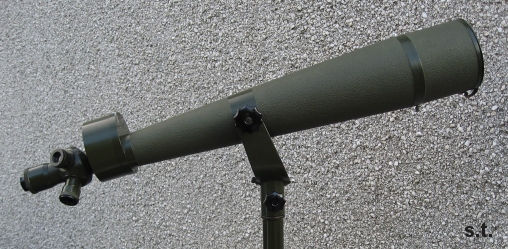
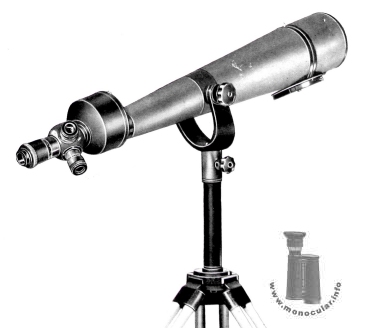
| Als Nachkriegs-Nachfolger des "Asimara"-Modells aus den 1930er Jahren kann das "Monokulare Aussichtsfernrohr 110/750" gelten, dass von VEB Carl Zeiss Jena nur kurz, ca. zwischen 1959 und 1961 (?) gebaut wurde (s. Bild aus einem engl. Zeiss Katalog von 1959). Es hat ein Okularrevolver mit orhtoskopischen Okularen der Vergrößerung 19x, 30x und 47x (markiert neben den Okularen; f = 40mm, 25mm, 16mm). Während beim Vorkriegs-Asimara mit einem Drehring zwischen Prismengehäuse und Okularrevolver fokussiert wird, ist beim Nachkriegsmodell jedes Okular mit einer Dioptrieneinstellung zum Scharfstellen ausgerüstet. Das Fernrohr ist grün lackiert wie andere Zeiss-Optiken aus der Zeit, dabei hat das Prismengehäuse und die Stativhalterung sowie die Okulare und der Objektivschutzdeckel eine glatte Oberfläche und der konische Tubus hat eine strukturierte Oberfläche. Das Monokulare Aussichtsfernrohr hat eine Kimme-Korn-Visiereinrichtung und einen wegklappbaren Objektivdeckel wie das Vorkriegs-Asimara. Die Kimme ist ein am unteren Prismengehäusedeckel geschraubtes Metallplättchen. Die Gabelhalterung für das Stativ wird mit einem Schraubrad fixiert; so auch das Gabelrohr auf dem Stativdorn. Am oberen Prismengehäusedeckel ist ein Beschriftungsschild angeschraubt, das mit dem Zeiss-Linsenlogo sowie der Seriennummer und dem "1Q" Qualitätszeichen mit der Nummer 00588 darunter gekennzeichnet ist. Es gab auch Exportmodelle mit Beschriftung "Jena" anstelle des Zeiss-Logos. Nicht alle, aber einige Exemplare haben auch ein als 110mm im Durchmesser und 750mm Brennweite gekennzeichnetes C-Objektiv. Die Seriennummern der bekannten Exemplare liegen alle zwischen 20670 bis 208xx. |
Being similar to the "Asimara" pre-war model from the 1930s the "Monokulare Aussichtsfernrohr 110/750" canb e considered its successor. This monocular look-out telescope was made by VEB Carl Zeiss Jena only for a short time between c. 1959 and 1961 (?) (cf. Bild form an Engl. Zeiss catalogue of 1959). It has a eyepiece turret with three orthoscopic eypeices with 19x, 30x and 47x power (marked next to the eypüeices on the turret; f = 40mm, 25mm, 16mm). While the pre-war Asimara was focused by a turniong ring on the tube between the prism housing and the eyepiece revolver, the post-war model comes with dioptre adjustments on each eyepiece. The telescope is lacquered green like other Zeiss optics of that period. The prism housing, the tripod clamp, the eyepeices and the objective cap have a smooth surface whereas the concial tube has a textured finish. The monocular telescope has a bead and notch sight and a fold-down objective protection cap like the pre-war Asimara. The notch is a small metal plate screwed onto the lower prism hosuing side. The yoke mount for the tripod can be tightende with a screw wheel just like the xoke tube on the tripod rod. A labeling plate is screwed onto the top cover of the prism housing. It bears the Zeiss lens logo, the serial number, and the "1Q" quality sign with number 00588 below. There also were export models marked "Jena" isntead of the Zeiss logo. Not all, but some specimen came with a type C objective retainer ring being inscribed with its specifications, i.e. 110mm diameter and a 750mm focal length. The serial numbers of the known models range between 20670 and 208xx. |
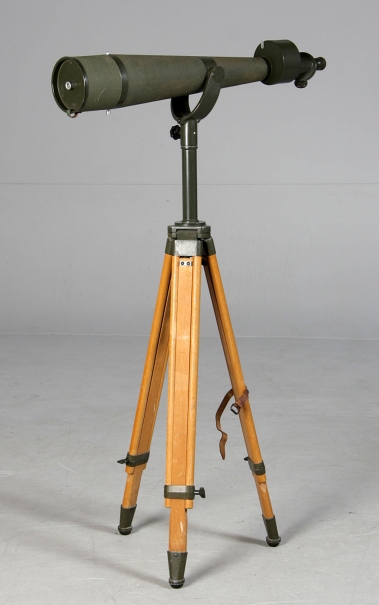
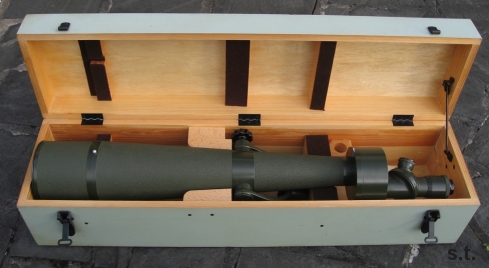
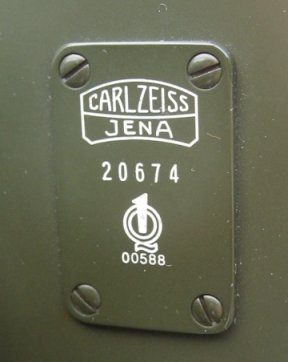
| Das Monokulare Aussichtsfernrohr hat einen Luftspaltachromat mit 3 kleinen silbernen Distanzplättchen zwischen den Linsen und ein Porro-2-Prismensystem im runden Gehäuse. Es wurde mit Stativ und entweder einer Holztransportkiste oder einem großen Lederbehälter vertrieben. Das 6,8kg schwere Monokular ist je nach Okularnutzung und Dioptrieneinstellung zwischen 83 und 90cm lang. Im 95x24x23cm großem Holzkasten wiegt es laut Prospekt 17kg, das Stativ 5kg. Das 66mm lange Prismengehäuse ist 120mm im Durchmesser, der Objektivtubus verbreitert sich von 64mm auf 135mm am Ende im Durchmesser. Die Objektivlinse ist um 12cm in den Tubus als Blendschutz zurück versetzt. Der Okularrevovler misst 80mm im Durchmesser; die Okulare haben folgende Maße - 47x, 30x, 19x: Okulartubus 43mm, 31mm, 31mm im Durchmesser, Fokussierungsring 47mm, 37mm, 36mm im Durchmesser, Kunststoffaugenmuschel 39mm, 34mm, 34mm im Durchmesser. |
The monocular look-out telescope has a air-space achromatic lens with three tiny silvery tin plates as spacers. It comes with a porro 2 prism system within the round prism housing. It was sold with a tripod and a wooden box or a leather case. The 6.8 kg monocular is 83 to 90cm long depending on dioptre adjsutment and eyepeice used. According to the catalogue the telescope and the wooden box weigh 17kg togehter, and the tripod weighs 5kg. The box is 95x24x23cm wide. The 66mm long prism housing is 120mm in diameter, the objective tube increases from 64mm to 135mm in diameter at its end. The objective lens is retracted by 12cm as a sunshade. The eyepiece turret is 80mm in diameter. The eyepieces come with the following specifications - 47x, 30x, 19x: eyepiece tube 43mm, 31mm, 31mm in diameter, focusing ring 47mm, 37mm, 36mm in diameter, plastic eyecup 39mm, 34mm, 34mm in diameter. |

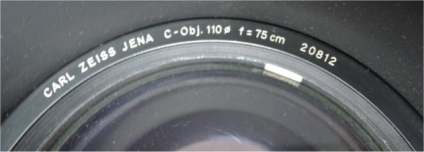
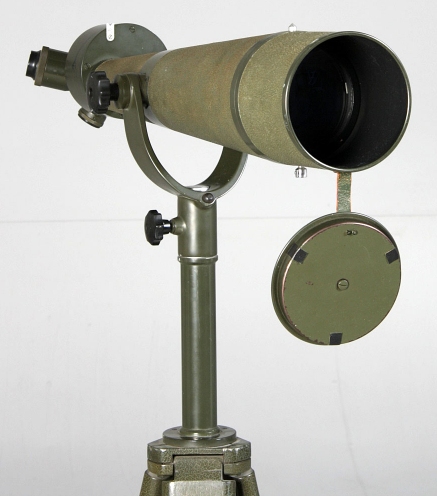
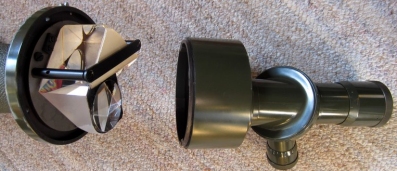
Fotos: Auktionen; 1,5: S. Tomlinson

